The RCI2995DX radio is built on a mostly surface-mount circuit board, but it's still vulnerable to the same breakdowns as the older and easier-to-service pre-DX 2950-type radios.
The AM modulator transistor Q66 was routinely installed at the factory with little or no heat-conducting compound smeared onto the insulating washer where it's bolted to the heat sink. This alone triggered a lot of failures. And if a final transistor were to fail shorted, Q66 would frequently get 'sideswiped' and fail from the overload. The 2SB754, 2SB827, 2SB688, NTE37, TIP36 or whatever transistor in this spot is not a big trick to replace if it breaks down. This pic is from an older 2517 radio, but you get the idea.
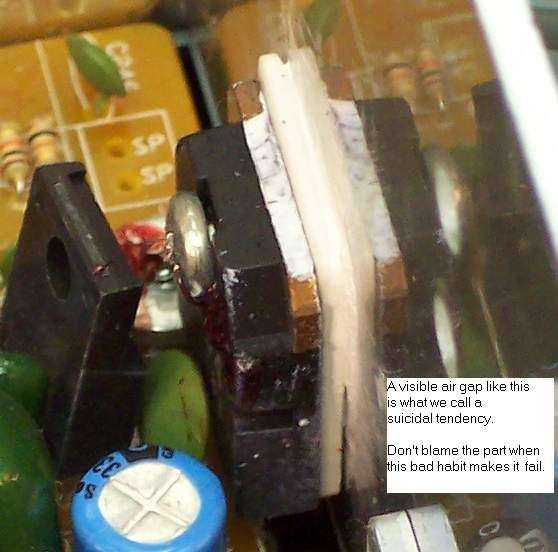
We did learn (the hard way) to install a single fuse block in line with the orange wire feeding power to the radio circuit board in the high-power base stations. After all, you wouldn't operate a 3-Amp mobile radio from a 30-Amp power supply without a fuse would you? But that's what's inside a 2995DX.
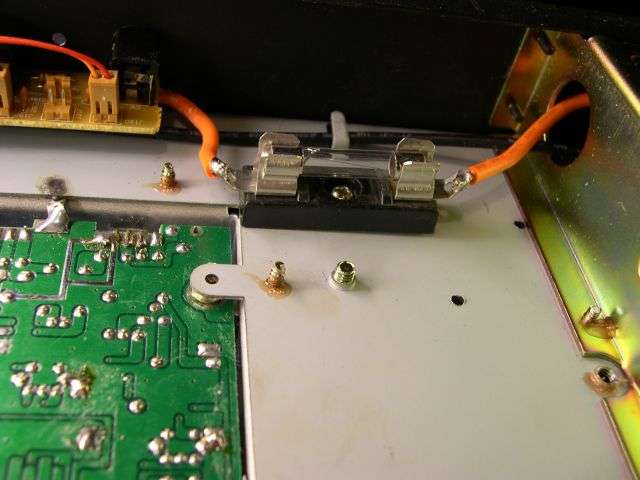
Newer radios with MOSFET finals/driver make the problem worse, since Q66 must now pump more current into them than the older bipolar transistors required.
Now and again when Q66 fails it will also blow out the smaller transistor that drives it, Q67. In the older radios Q67 was a fat TO-220 type transistor installed standing up on the pc board right alongisde Q66 just like in the first pic above. Didn't need a heatsink, but using a transistor this large allowed it to tolerate current peaks.
In the "DX" radios, Q67 is a surface-mount power transistor. It's a big pain to remove, since the entire lower surface of the part is metal, soldered to a fairly-fragile foil trace. It's not uncommon for this trace to come away with Q67 when it's removed the first time. Even if you're really good that trace will certainly come away the next time Q67 fails. It takes some heat to get it loose.
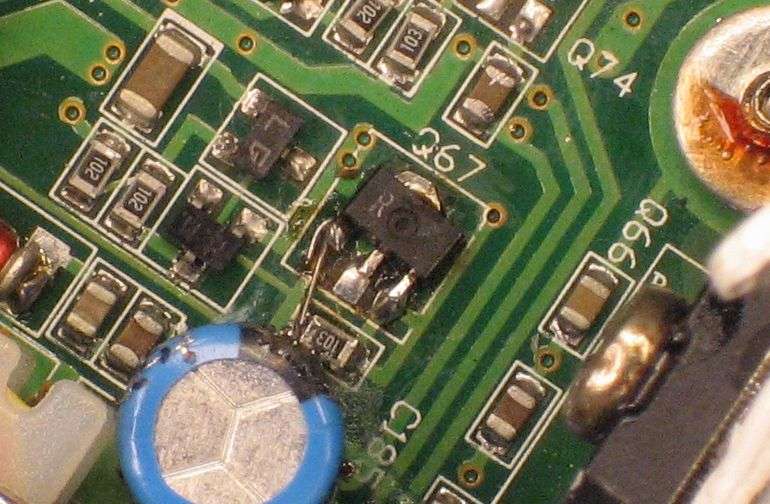
The fix that we worked out is to use a TO-220 transistor like the part used in the older 2950-type radios. Easiest way is to use one that's totally enclosed in plastic with no metal tab. Saves you the trouble of finding the mica and shoulder washers to mount it. The type number in the pic is 2SA1869.
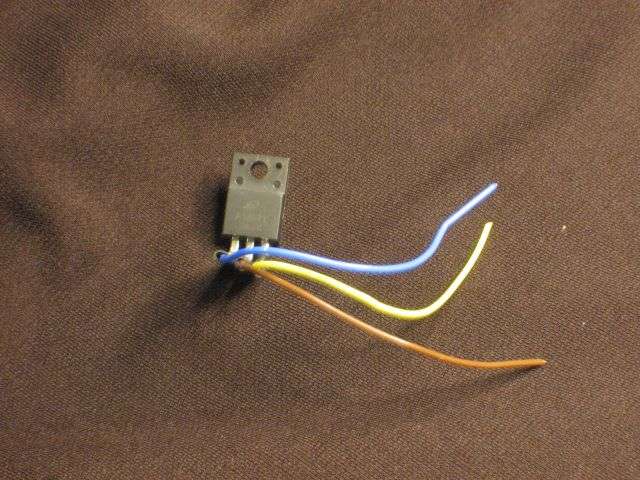
Yes, this part simply stands up on the older radio with the through-hole pc board. But mounting it to a spare hole on the big heat sink alongside Q66 is just easier. Doesn't require a heat sink, but that's the simplest place to mount it.
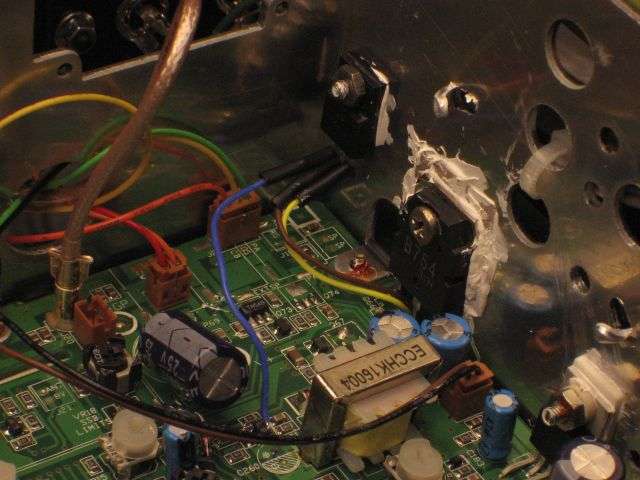
The yellow wire is the emitter. The brown wire is the collector. These simply lap-solder to the pads for Q66. Q67 emitter goes to Q66 base. Q67 collector goes to Q66 collector.
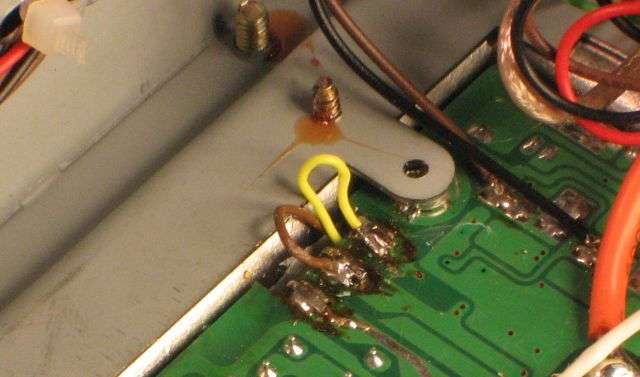
The blue wire is the base lead of Q67. That goes to the collector (side with the single lead) of Q65.
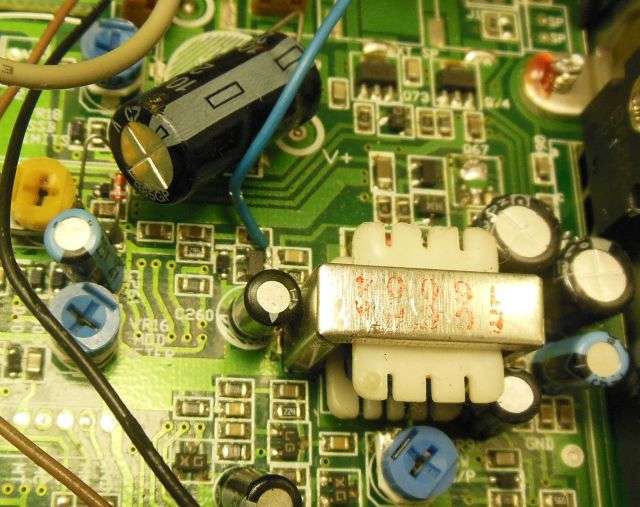
Here's a closer-up view of Q65 collector with the blue wire lap-soldered to its collector lead.
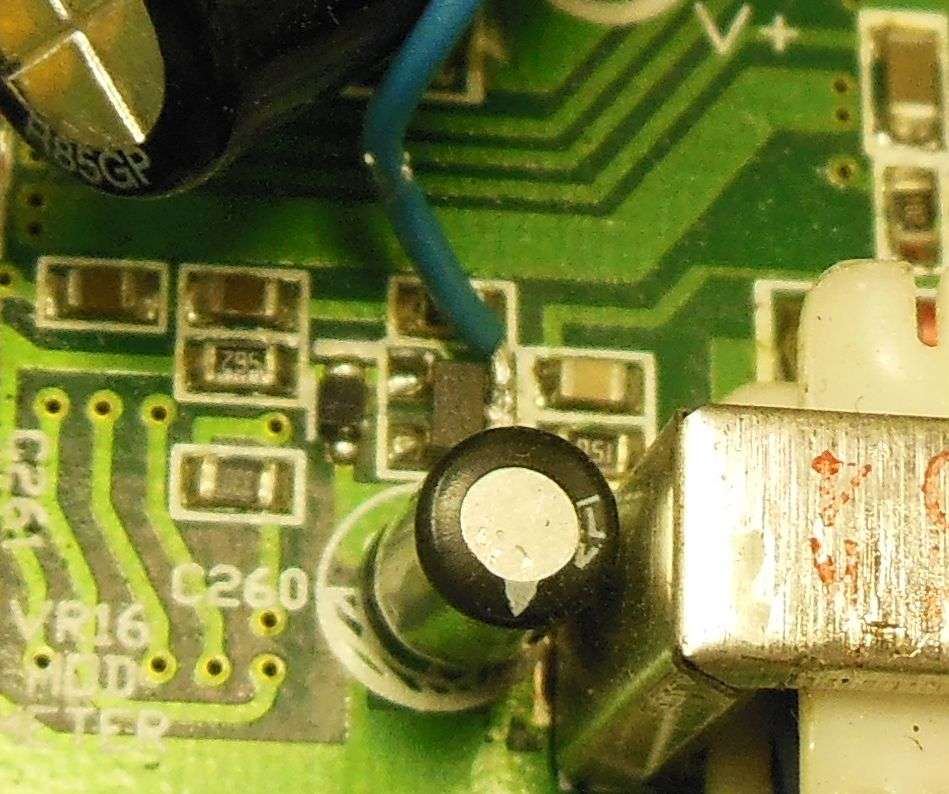
It's rare to have the opportunity to replace a failed SMT part with a more-robust conventional part. I have seen more than a few attempts to "stand up" a part with wire leads soldered to the tiny solder pads on a SMT circuit board. This sort of repair usually looks as if it would fall apart if you blew on it too hard, with wire leads standing up above the board surface.
But this trick has gotten us out of trouble with the "DX" radios a time or two.
73
The AM modulator transistor Q66 was routinely installed at the factory with little or no heat-conducting compound smeared onto the insulating washer where it's bolted to the heat sink. This alone triggered a lot of failures. And if a final transistor were to fail shorted, Q66 would frequently get 'sideswiped' and fail from the overload. The 2SB754, 2SB827, 2SB688, NTE37, TIP36 or whatever transistor in this spot is not a big trick to replace if it breaks down. This pic is from an older 2517 radio, but you get the idea.

We did learn (the hard way) to install a single fuse block in line with the orange wire feeding power to the radio circuit board in the high-power base stations. After all, you wouldn't operate a 3-Amp mobile radio from a 30-Amp power supply without a fuse would you? But that's what's inside a 2995DX.

Newer radios with MOSFET finals/driver make the problem worse, since Q66 must now pump more current into them than the older bipolar transistors required.
Now and again when Q66 fails it will also blow out the smaller transistor that drives it, Q67. In the older radios Q67 was a fat TO-220 type transistor installed standing up on the pc board right alongisde Q66 just like in the first pic above. Didn't need a heatsink, but using a transistor this large allowed it to tolerate current peaks.
In the "DX" radios, Q67 is a surface-mount power transistor. It's a big pain to remove, since the entire lower surface of the part is metal, soldered to a fairly-fragile foil trace. It's not uncommon for this trace to come away with Q67 when it's removed the first time. Even if you're really good that trace will certainly come away the next time Q67 fails. It takes some heat to get it loose.

The fix that we worked out is to use a TO-220 transistor like the part used in the older 2950-type radios. Easiest way is to use one that's totally enclosed in plastic with no metal tab. Saves you the trouble of finding the mica and shoulder washers to mount it. The type number in the pic is 2SA1869.

Yes, this part simply stands up on the older radio with the through-hole pc board. But mounting it to a spare hole on the big heat sink alongside Q66 is just easier. Doesn't require a heat sink, but that's the simplest place to mount it.

The yellow wire is the emitter. The brown wire is the collector. These simply lap-solder to the pads for Q66. Q67 emitter goes to Q66 base. Q67 collector goes to Q66 collector.

The blue wire is the base lead of Q67. That goes to the collector (side with the single lead) of Q65.

Here's a closer-up view of Q65 collector with the blue wire lap-soldered to its collector lead.

It's rare to have the opportunity to replace a failed SMT part with a more-robust conventional part. I have seen more than a few attempts to "stand up" a part with wire leads soldered to the tiny solder pads on a SMT circuit board. This sort of repair usually looks as if it would fall apart if you blew on it too hard, with wire leads standing up above the board surface.
But this trick has gotten us out of trouble with the "DX" radios a time or two.
73
